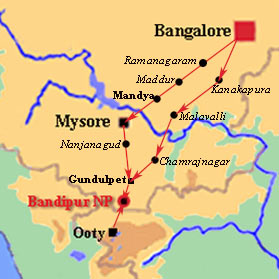Home ::Indian National Parks :: Bandipur National Park
Bandipur National Park
Bandipur National Park, established in 1973 as a tiger reserve under Project Tiger, is a national park located in the south Indian state of Karnataka. It was once a private hunting reserve for the Maharaja of the Kingdom of Mysore. Bandipur is known for its wildlife and has many types of biomes, but dry deciduous forest is dominant.
Bandipur is located in Gundlupet taluq of Chamarajanagar district. It is about 80 kilometers (50 mi) from the city of Mysore on the route to a major tourist destination of Ooty. As a result, Bandipur sees a lot of tourist traffic and there are a lot of wildlife fatalities caused by speeding vehicles that are reported each year. There is a ban on traffic from the hours of dusk to dawn to help bring down deaths of wildlife.

The park spans an area of 874 square kilometers (337 sq mi), protecting several species of India's endangered wildlife. Together with the adjoining Nagarhole National Park (643 km2 (248 sq mi)), Mudumalai National Park (320 km2 (120 sq mi)) and Wayanad Wildlife Sanctuary (344 km2 (133 sq mi)), it is part of the Nilgiri Biosphere Reserve totaling 2,183 km2 (843 sq mi) making it the largest protected area in southern India.

Bandipur National park is a part of the Nilgiri forest range. Its a rain forest and hence the forest cover is thick and beautiful throughout the year. Jungle Lodges (JLR) is a good resort to stay in Bandipur (and other parks in karnataka as well). The only problem is that the Mysore-ooty highway cuts across the park and the resort is also located along the highway. So one does not feel completely in the presence of nature during the time spent at the resort because of the constant sound of vehicles.
Bandipur National Park located between 75° 12' 17" E to 76° 51' 32" E and 11° 35' 34" N to 11° 57' 02" N where the Deccan Plateau meets the Western Ghats and the altitude of the park ranges from 680 meters (2,230 ft) to 1,454 meters (4,770 ft). As a result, the park has a variety of biomes including dry deciduous forests, moist deciduous forests and shrublands. The wide range of habitats help support a diverse range of organisms. The park is flanked by the Kabini river in the north and the Moyar river in the south. The Nugu river runs through the park. The highest point in the park is on a hill called Himavad Gopalaswamy Betta, where there is a Hindu temple at the summit. Bandipur has typical tropical climate with distinct wet and dry seasons. The dry and hot period usually begins in early March and can last till the arrival of the monsoon rains in June.
The safari however was good. Once the safari jeep goes in to the jungle, it is a truly wild experience. There is a high density of wild elephants here. We also managed to spot gaurs, leopards, wild dogs, sambar deers, chitals, boars, serpent eagle, malabar squirrel , the brainfever bird and some other bird species as well. We were unlucky not to see a tiger but extremely lucky to see a pack of wild dogs hunt down a sambar deer right in front of the vehicle. JLR folks had also arranged for a nature walk. Even though the overall experience was commercial, it wasnt bad. The large number of visitors during the weekends results in a large number of safari vehicles (also from other resorts and the public ones)that go into the forest and will make it difficult to spot shy creatures like tigers and leopards. So ,to experience the best of bandipur, my advice would be to take a couple of days off work and visit it in the week days.



